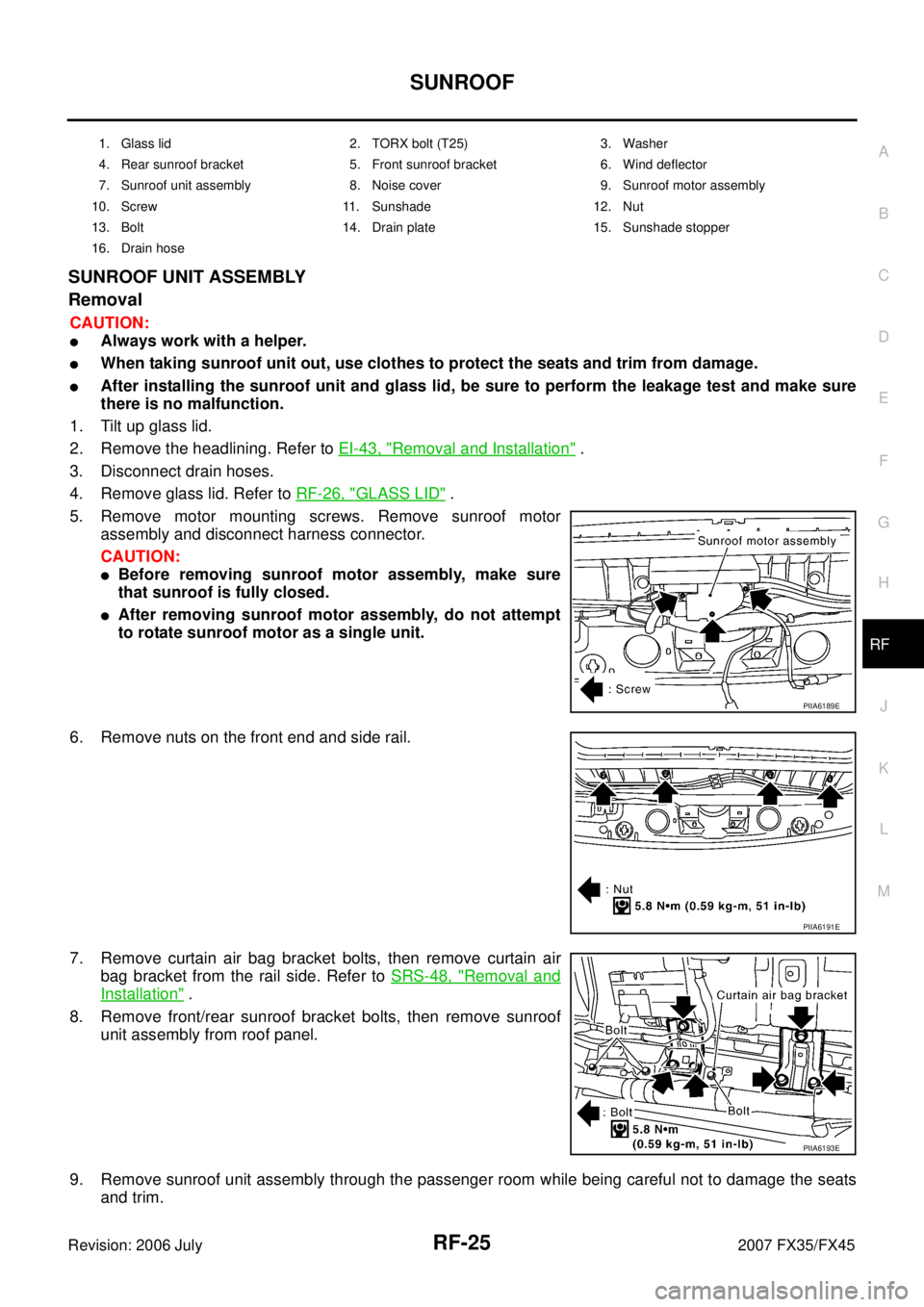Page 3909 of 4366

SQUEAK AND RATTLE TROUBLE DIAGNOSES RF-7
C
D E
F
G H
J
K L
M A
B
RF
Revision: 2006 July 2007 FX35/FX45
TRUNK
Trunk noises are often caused by a loose jack or loose items put into the trunk by the owner.
In addition look for:
1. Trunk lid dumpers out of adjustment
2. Trunk lid striker out of adjustment
3. Trunk lid torsion bars knocking together
4. A loose license plate or bracket
Most of these incidents can be repaired by adjusting, securing or insulating the item(s) or component(s) caus-
ing the noise.
SUNROOF/HEADLINING
Noises in the sunroof/headlining area can often be traced to one of the following:
1. Sunroof lid, rail, linkage or seals making a rattle or light knocking noise
2. Sunvisor shaft shaking in the holder
3. Front or rear windshield touching headlining and squeaking
Again, pressing on the components to stop the noise while duplicating the conditions can isolate most of these
incidents. Repairs usually consist of insulating with felt cloth tape.
SEATS
When isolating seat noise it's important to note the position the seat is in and the load placed on the seat when
the noise is present. These conditions should be duplicated when verifying and isolating the cause of the
noise.
Cause of seat noise include:
1. Headrest rods and holder
2. A squeak between the seat pad cushion and frame
3. Rear seatback lock and bracket
These noises can be isolated by moving or pressing on the suspected components while duplicating the con-
ditions under which the noise occurs. Most of these incidents can be repaired by repositioning the component
or applying urethane tape to the contact area.
UNDERHOOD
Some interior noise may be caused by components under the hood or on the engine wall. The noise is then
transmitted into the passenger compartment.
Causes of transmitted underhood noise include:
1. Any component mounted to the engine wall
2. Components that pass through the engine wall
3. Engine wall mounts and connectors
4. Loose radiator mounting pins
5. Hood bumpers out of adjustment
6. Hood striker out of adjustment
These noises can be difficult to isolate since they cannot be reached from the interior of the vehicle. The best
method is to secure, move or insulate one component at a time and test drive the vehicle. Also, engine RPM
or load can be changed to isolate the noise. Repairs can usually be made by moving, adjusting, securing, or
insulating the component causing the noise.
Page 3927 of 4366

SUNROOF RF-25
C
D E
F
G H
J
K L
M A
B
RF
Revision: 2006 July 2007 FX35/FX45
SUNROOF UNIT ASSEMBLY
Removal
CAUTION:
�Always work with a helper.
�When taking sunroof unit out, use clothes to protect the seats and trim from damage.
�After installing the sunroof unit and glass lid, be sure to perform the leakage test and make sure
there is no malfunction.
1. Tilt up glass lid.
2. Remove the headlining. Refer to EI-43, "
Removal and Installation" .
3. Disconnect drain hoses.
4. Remove glass lid. Refer to RF-26, "
GLASS LID" .
5. Remove motor mounting screws. Remove sunroof motor assembly and disconnect harness connector.
CAUTION:
�Before removing sunroof motor assembly, make sure
that sunroof is fully closed.
�After removing sunroof motor assembly, do not attempt
to rotate sunroof motor as a single unit.
6. Remove nuts on the front end and side rail.
7. Remove curtain air bag bracket bolts, then remove curtain air bag bracket from the rail side. Refer to SRS-48, "
Removal and
Installation" .
8. Remove front/rear sunroof bracket bolts, then remove sunroof unit assembly from roof panel.
9. Remove sunroof unit assembly through the passenger room while being careful not to damage the seats and trim.
1. Glass lid 2. TORX bolt (T25) 3. Washer
4. Rear sunroof bracket 5. Front sunroof bracket 6. Wind deflector
7. Sunroof unit assembly 8. Noise cover 9. Sunroof motor assembly
10. Screw 11. Sunshade 12. Nut
13. Bolt 14. Drain plate 15. Sunshade stopper
16. Drain hose
PIIA6189E
PIIA6191E
PIIA6193E
Page 3928 of 4366
RF-26
SUNROOF
Revision: 2006 July 2007 FX35/FX45
Installation
1. Temporarily tighten the mounting bolts on the front/rear sunroof
brackets (RH/LH).
2. Bring sunroof unit assembly into passenger room and place the rear end of the rail onto the sunroof brackets.
3. Tighten the mounting nuts on the front end.
4. Tighten the installation points diagonally excluding the installation point of the sunroof bracket around the roof opening.
5. Tighten the bolts on the sunroof bracket to the vehicle side and then tighten the bolt to the rail side.
6. Tighten the bolts on the curtain air bag bracket to the rail side. Refer to SRS-48, "
Removal and Installation" .
GLASS LID
Removal
1. Tilt up glass lid.
2. Remove TORX bolts (T25) from remove glass lid.
Installation
1. Tighten bolts diagonally on the glass lid.
2. After installation, carry out fitting adjustment.
PIIA6193E
PIIA6191E
PIIA6193E
PIIA6192E
Page 4046 of 4366

SE-8
SQUEAK AND RATTLE TROUBLE DIAGNOSES
Revision: 2006 July 2007 FX35/FX45
TRUNK
Trunk noises are often caused by a loose jack or loose items put into the trunk by the owner.
In addition look for:
1. Trunk lid dumpers out of adjustment
2. Trunk lid striker out of adjustment
3. The trunk lid torsion bars knocking together
4. A loose license plate or bracket
Most of these incidents can be repaired by adjusting, securing or insulating the item(s) or component(s) caus-
ing the noise.
SUNROOF/HEADLINING
Noises in the sunroof/headlining area can often be traced to one of the following:
1. Sunroof lid, rail, linkage or seals making a rattle or light knocking noise
2. Sun-visor shaft shaking in the holder
3. Front or rear windshield touching headlining and squeaking
Again, pressing on the components to stop the noise while duplicating the conditions can isolate most of these
incidents. Repairs usually consist of insulating with felt cloth tape.
SEATS
When isolating seat noise it's important to note the position the seat is in and the load placed on the seat when
the noise is present. These conditions should be duplicated when verifying and isolating the cause of the
noise.
Cause of seat noise include:
1. Headrest rods and holder
2. A squeak between the seat pad cushion and frame
3. The rear seatback lock and bracket
These noises can be isolated by moving or pressing on the suspected components while duplicating the con-
ditions under which the noise occurs. Most of these incidents can be repaired by repositioning the component
or applying urethane tape to the contact area.
UNDERHOOD
Some interior noise may be caused by components under the hood or on the engine wall. The noise is then
transmitted into the passenger compartment.
Causes of transmitted under-hood noise include:
1. Any component mounted to the engine wall
2. Components that pass through the engine wall
3. Engine wall mounts and connectors
4. Loose radiator mounting pins
5. Hood bumpers out of adjustment
6. Hood striker out of adjustment
These noises can be difficult to isolate since they cannot be reached from the interior of the vehicle. The best
method is to secure, move or insulate one component at a time and test drive the vehicle. Also, engine RPM
or load can be changed to isolate the noise. Repairs can usually be made by moving, adjusting, securing, or
insulating the component causing the noise.